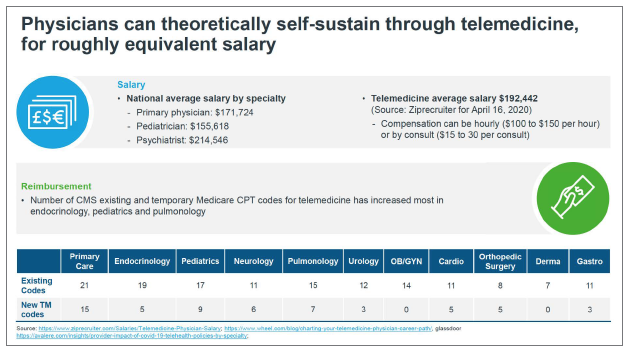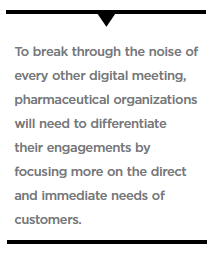The life-sciences industry is starting to find a new baseline, adapting to the abrupt remote digital pivot many organizations needed to make. While we acknowledge in recent years the industry has been on a path toward digital transformation, there’s no denying that the complications arising from the COVID-19 pandemic have accelerated that process for many organizations.
Often when we make quick adjustments to address immediate circumstances, though, we find ourselves building mediocre or insufficiently scalable solutions that show cracks and widen gaps over time. Many organizations in the life-sciences industry have experienced this, as quickly erected digital strategies struggle to meet expectations around impact to business and the patients.
Digital footprints will continue to grow so it is likely that large omnichannel engagement strategies will need to be refined even as they expand. That means there is an opportunity now to not only address immediately apparent challenges, but also to identify and redefine the investments that can maximize returns in the longer term. After all, many of the challenges felt by organizations who stood up solutions in the last few months are shared by organizations who have been on journeys of digital transformation for several years.
Avoiding Remote Engagement Fatigue while Navigating Remote Interactions
 Healthcare providers (HCPs) are no different than other professionals, spending more and more time meeting with their colleagues — and even their patients — digitally. And like most technological leaps, particularly those that make healthcare more efficient, we can expect HCPs to continue to spend a significant portion of time on telemedicine after COVID-19. With most of their professional lives playing out online, HCPs may be finding it difficult to justify engaging with pharmaceutical representatives on the same channel if they don’t perceive tremendous value from those interactions. Not only is there a cost of time and energy to face the screen, but the physical separation facilitates the brushing off of the visit — it’s a lot harder to turn someone away from your office when they are waiting for you outside the door.
Healthcare providers (HCPs) are no different than other professionals, spending more and more time meeting with their colleagues — and even their patients — digitally. And like most technological leaps, particularly those that make healthcare more efficient, we can expect HCPs to continue to spend a significant portion of time on telemedicine after COVID-19. With most of their professional lives playing out online, HCPs may be finding it difficult to justify engaging with pharmaceutical representatives on the same channel if they don’t perceive tremendous value from those interactions. Not only is there a cost of time and energy to face the screen, but the physical separation facilitates the brushing off of the visit — it’s a lot harder to turn someone away from your office when they are waiting for you outside the door.
Aside from the given barrier of social distancing and closed offices due to the pandemic, increases in telemedicine over time will continue to decrease in-person opportunities for representatives to make office visits — and will certainly limit the chances that a provider would be willing to accept an unprompted meeting. We were already seeing these trends before the pandemic.
In order to break through the noise of every other digital meeting, and eventually the generally low priority for commercial and purely brand-focused discussions, pharmaceutical organizations will need to differentiate their engagements by focusing more on the direct and immediate needs of customers. HCPs will need to justify taking time away from patients and colleagues — both in and out of the office — to interact with the life-sciences industry. That means organizations need to focus on:
Increased and improved medical, clinical, and scientific content during discussions
Simple, user-friendly tools for HCP engagement and detailing that support exchanges rather than “message delivery"
Streamlined, virtual group meetings, and conference series that engage HCPs and promote peer interactions
Orchestrated channels that drive HCPs to self-service relevant, useful and easy-to-locate content
Investing in the Right Channels at the Right Time, Backed by Data
The life-sciences Industry is rarely at a loss for data — reference data, payer data, point of service data, third party data, customer data, and so much more. When it comes to cutting through the digital noise while HCPs are inundated with content, current and prospective (rather than retrospective) insights on engagement, revenue, and profitability of campaigns is critical. Prospective insights can only be generated from continuously updated data sets that are brought together, with smart algorithms that can anticipate events and identify trends just as they’re starting.
Digital content and channels provide agility and the opportunity to shift course quickly in response to customer engagement patterns. In order to maximize that flexibility, you need to identify what’s working and what isn’t — and that requires more than raw data points.
Brand-level planning needs to be done across channels — digital and face-to-face, person-led and automated — with specific metrics defined upfront to evaluate engagement across different messaging, content formats, channels, frequency, and timing. These metrics need to factor in engagement sequencing and enable alternatives to be deployed as soon as analyses point to opportunities for optimization. AI/ML capabilities, as well as expertise in implementing the necessary algorithms and recommendation rules that work for humans to understand and follow, play a crucial role in those early planning stages. The engagement journey becomes just as high a priority as content updates.
Serving the Best Content in the Best Context
Now that face-to-face meetings come at a premium, and as digital engagement becomes more saturated, channel and frequency are only one part of the equation for effective strategy. The industry needs to pay special attention to content development. Content for in-person dissemination needs to gravitate toward scientific and clinical information that is both up to date, thorough yet easy to follow to address the concern HCPs will have in justifying time spent with commercial teams.
 The role of scientific and clinical thought leaders must be prioritized, and as such companies will need to invest in developing content for enduring activities such as patient cases, new real world evidence focused publications, and peer opinion pieces. Ensuring this content is well cascaded and widely consumed, requires a clear understanding of influence networks, channel preferences and tracking reactions at the “point of interaction" with each customer. Keeping highest-value content for (increasingly rare) face-to-face engagement means other common requests or content offers must be delegated to automated digital channels: eprints/reprints, meeting invitations, scheduling follow-ups, “MSL- or nurse educator-on-demand" requests.
The role of scientific and clinical thought leaders must be prioritized, and as such companies will need to invest in developing content for enduring activities such as patient cases, new real world evidence focused publications, and peer opinion pieces. Ensuring this content is well cascaded and widely consumed, requires a clear understanding of influence networks, channel preferences and tracking reactions at the “point of interaction" with each customer. Keeping highest-value content for (increasingly rare) face-to-face engagement means other common requests or content offers must be delegated to automated digital channels: eprints/reprints, meeting invitations, scheduling follow-ups, “MSL- or nurse educator-on-demand" requests.
The fast pace of digital, compared with the traditional cadence of an in-person centric strategy, demands a constant churn of content (real world data, patient case or series, hosted clinical sessions) every few weeks — and the technology to support it. In addition to the usual compliance and regulatory requirements surrounding review, production, and distribution, companies need to address the performance of content.
Since the objective of a robust digital program supporting a comprehensive omnichannel strategy is to continuously build brand equity over time, our analysis — and therefore the technology we use to run it — needs to be sophisticated enough to support both marketing and sales teams, including smart tracking of content consumption and customer reaction. It is important to ensure this content can produced and delivered in modular form, adapted to distinct channels, and the reaction and rate of consumption measured at every opportunity. Only then can both the impact of the content, channel, frequency and format be understood. This knowledge can then be reflected in the next round of engagement investments, whether they cover more content production, paid advertising, events, thought leader contracts, etc.
Transitioning from Reaction to Proaction
The past few months have no doubt been challenging to say the least, and required significant agility and adaptability for organizations.
Moving forward, we should continue to invest in maturing digital strategies and the technologies and expertise required to enable them.
If you’re interested in learning more about what pharmaceutical organizations are doing to rapidly deploy digital engagement content, visit https://www.iqvia.com/locations/united-states/insights and select the topic “Covid-19".(PV)
IQVIA is a leading global provider of advanced analytics, technology solutions and contract research services to the life sciences industry.
For more information, visit iqvia.com.
















